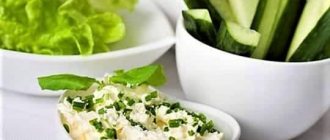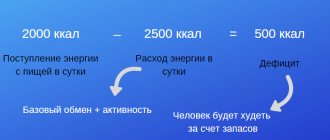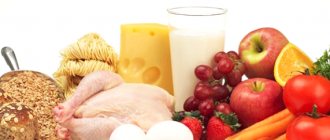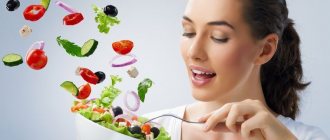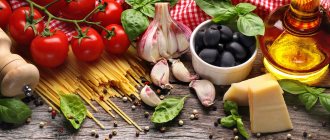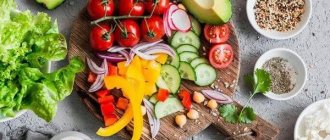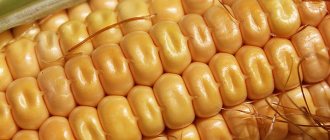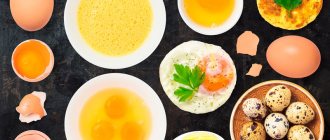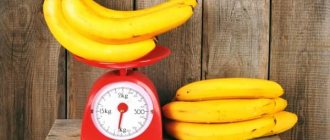BUTCH diet plan
The BUTCH diet can last from 4 to 30 days. A person must independently decide which option suits him best. This largely depends on your initial body weight and what result you want to achieve. An important condition is that the number of days during the diet must be a multiple of four.
The most effective BEACH diet plan:
- First day: the daily dose of protein is calculated based on the scheme of 3-4 g of protein per 1 kg of weight. The amount of carbohydrates from food is equal to 25 g, and the amount of fat to 30 g.
- The second day is similar to the first day.
- The third day involves eating 1 g of protein and 6 g of carbohydrates per 1 kg of weight. Fats should be present in the menu, but not more than 30 g per day.
- During the 4th day of the diet, you need to consume 3 g of protein and 3 g of carbohydrates per kilogram of weight. The amount of fat remains unchanged.
In addition to the classic scheme of alternating days on a BEACH diet presented above, there are its variations:
- 2+2 (protein days + carbohydrate days).
- 2+1 (protein days + carbohydrate days).
- 3+1+1 (protein + carbohydrate + protein-carbohydrate).
- 2+2+2 (protein + carbohydrates + protein-carbohydrates).
The daily caloric intake for women on any of these days should be equal to 1200 kcal.
A regimen that includes a large number of protein days is more suitable for gaining muscle mass. At the same time, fat will also be burned. Be sure to exercise while dieting.
Experts consider the optimal regimen to be one in which 2 protein days alternate with 2 carbohydrate days. If you increase the number of protein days, it will be more difficult for the body to tolerate the diet.
As for quitting the diet, it is not particularly difficult. To do this, it is enough to continue to eat a mixed diet for another week, introducing foods from the usual menu into the diet every day.
General points in diet planning
The effectiveness of this diet is based on an understanding of the biological mechanisms leading to weight loss due to fat reserves. To do this, the nutrition program is based on alternating 3 successive stages:
- Protein stage. Each meal consists of foods high in protein. At this stage, it is permissible to include fresh or stewed vegetables in the diet, avoiding any dishes with a carbohydrate component. The duration of the protein stage is from 2 to 5 days, depending on the degree of physical activity of the person. If you are not working on building muscle in your body, but are simply trying to lose weight while maintaining muscle, stick to the protein phase for 3-4 days. During this time, the body will use up all available reserves of carbohydrates and start the process of burning fat - lipolysis.
- The carbohydrate stage lasts only one day and is aimed at partially replenishing glycogen reserves. This is done in order to prevent a slowdown in metabolism and to avoid the “plateau effect” known to everyone who loses weight, i.e. stopping weight loss. The basis of the diet on this day will be sources of slow carbohydrates (porridge, muesli, durum wheat pasta) and fruits.
photo from the site https://evehealth.ru/
- Mixed stage – lasting one day. It is also aimed at stabilizing metabolism and represents a proper, balanced diet, which contains all nutrients (proteins, fats, carbohydrates, fiber) in physiological proportions. If the BUTCH diet is chosen, the monthly menu will contain from 4 to 8 mixed days.
For those who have chosen protein-carbohydrate alternation, the menu at all stages must meet a number of general requirements:
- The calorie content of the diet should be 15-20% less than the norm for a given person. Your individual norm, taking into account weight, age, height and degree of physical activity, can be calculated using online calculators or manually using the Mifflin-San Geor formula.
- Make a menu for BUCH in such a way that breakfast and lunch are the most nutritious, and in the afternoon all meals are light.
- Meals should be divided, with meals 5-7 times a day. Most often, a second breakfast and an afternoon snack are added to the standard three meals a day, and sometimes a light snack before bed.
- Since the BEACH diet menu is only partially balanced, it cannot provide a complete supply of micronutrients, so take care of taking a vitamin-mineral complex.
- The drinking regime is standard - 1.5-2 liters of liquid per day, but this is what girls losing weight often overlook.
photo from the site https://hochu.ua
Count it right!
If a BEACH diet is chosen for weight loss, the menu for girls weighing 60 kg with a height of 170 cm and playing sports 3 times a week is calculated based on a calorie content of approximately 1500 kcal. Every extra 10 kg of weight adds 100 kcal/day to the optimal caloric intake.
Results of the BUCH diet
The results of the BUC diet are presented in the following graph:
- Minus 0.5 kg - 1 kg in the first 1-2 days of the diet.
- Minus 0.5 kg - 1 kg on day 3-4 of the diet.
- On the fifth day of the diet, it is possible to regain the lost kilos due to the water that will be retained in the body by carbohydrate foods.
- On the sixth day of the diet, losses are similar to those that occur during the second day.
If you repeat the cycle, you will lose approximately 0.8 kg for each approach. However, during a BEACH diet, attention should be paid not to exactly how much a person has lost in kilograms, but to how much the volume has decreased.
BUTCH: carbohydrate day, menu in 4 options
Despite the promising name, these days have nothing to do with sweets and sugars. The diet will be based on slow carbohydrates, the breakdown of which occurs gradually, due to which the feeling of fullness remains for a long time. However, you will still treat yourself to something sweet, because at this stage of the carbohydrate rotation diet, the menu contains fresh fruits and dried fruits.
If the BEACH diet is chosen for weight loss, the menu for the week will include 1-2 carbohydrate days, depending on the duration of the protein stage. It follows from this that the given 4 daily sets of dishes will be enough so that each of them does not repeat more than twice a month.
BUTCH diet menu
BUTCH diet menu for the week:
| Breakfast | Snack | Dinner | Dinner | |
| Protein day No. 1 | Whipped cottage cheese, black coffee | Choice of: nuts, yogurt or kefir | Mushroom soup, stewed chicken and beans | Chicken liver in milk |
| Protein day No. 2 | Chicken frittata with mushrooms, glass of coffee | Rabbit meat with pea puree | Seafood in tomato sauce | |
| Day No. 3 - carbohydrate | Yachka cooked with milk | Any fruit | Vegetables and boiled rice | Warm vegetable salad, lentils |
| Day No. 4 - combined | Whole grain cereal with milk, glass of coffee | Any fruits, nuts or kefir | Vegetable soup, vegetables with beef fillet | Cheese casserole |
| Day No. 5 - protein | Cottage cheese, yogurt, coffee | Yogurt, nuts or kefir at the discretion of the person losing weight | Spinach puree soup, chicken fillet in soy sauce and kefir | Vegetable salad with Tofu cheese |
| Day No. 6 – protein | Omelette (2 whites + 1 yolk), glass of coffee | Red fish fillet, steamed red beans in tomato sauce | Beef stewed in cream, vegetable salad | |
| Day No. 7 - carbohydrate | Oatmeal porridge cooked with milk, cup of coffee | Any fruit | Vegetable soup with barley, boiled buckwheat with mushrooms | Pancakes with vegetable filling |
| Day No. 8 – leaving the diet | Omelet based on two chicken eggs, a cup of coffee | Nuts, kefir or fruits | Steamed white fish, pasta and spinach | Goat cheese and vegetables in salad |
Sample menu for the week
The diet helps you lose 0.5 to 3 kg per week, depending on your initial weight. Extra pounds do not go away as quickly, since muscles are heavier than fat. It is recommended to focus on body volumes and take measurements using a centimeter.
To adjust protein-carbohydrate alternation to individual needs, we offer a weekly menu designed for 2 alternation cycles. For a longer period, it is necessary to duplicate the days, maintaining the sequence.
| Mixed DAY: | |
| Breakfast | Cottage cheese with berries, coffee with cream |
| Lunch | Green or yellow apple |
| Dinner | Lentils, chicken broth and a piece of chicken fillet |
| Afternoon snack | Whole grain bread and a glass of tomato juice |
| Dinner | Boiled beef and stewed cabbage |
| Protein DAY: | |
| Breakfast | Protein omelet and herbal tea without sugar |
| Lunch | Any citrus |
| Dinner | Spinach soup and boiled eggs |
| Afternoon snack | Kefir |
| Dinner | Chicken cutlets with broccoli |
| Protein DAY: | |
| Breakfast | Cottage cheese casserole and unsweetened coffee with milk |
| Lunch | Kiwi |
| Dinner | Salmon in milk |
| Afternoon snack | Yogurt without additives |
| Dinner | Egg salad with avocado |
| Carbohydrate DAY: | |
| Breakfast | Oatmeal with pieces of fruit and honey, tea with honey |
| Lunch | Pears |
| Dinner | Sweet potato with yogurt |
| Afternoon snack | Dates |
| Dinner | Vegetable salad with quinoa |
| Mixed DAY: | |
| Breakfast | Cheesecakes with honey, coffee with cream |
| Lunch | Banana |
| Dinner | Seafood soup |
| Afternoon snack | Yogurt without additives |
| Dinner | Baked fish with vegetable salad |
| Protein DAY: | |
| Breakfast | Boiled egg whites, unsweetened herbal tea |
| Lunch | Citrus |
| Dinner | Egg soup with fish |
| Afternoon snack | Ryazhenka |
| Dinner | Turkey and grilled vegetables |
| Protein DAY: | |
| Breakfast | Omelet with shrimps, coffee without sugar with milk |
| Lunch | Green apple |
| Dinner | Cottage cheese with yogurt without additives |
| Afternoon snack | Curdled milk |
| Dinner | Green salad dressed with oil |
| Carbohydrate DAY: | |
| Breakfast | Rice porridge with raisins, coffee and bread |
| Lunch | Banana |
| Dinner | Noodles soup |
| Afternoon snack | Bakery product made from durum flour |
| Dinner | Potato dumplings |
Meals can be swapped. The main rule is to observe alternation.
Menu for 21 days
Products shown are exemplary. Each product on the menu is replaced every day with ingredients similar in macronutrient content.
| № | Type of days | Breakfast | Dinner | Dinner | Snacks |
| 1 | Protein | Low-fat cottage cheese | Fish baked with vegetables | Egg white omelette | Steamed fish or vegetables |
| 2 | Protein | Grilled veal, vegetables | Chicken with Chinese cabbage salad | Low-fat cottage cheese | Egg or seafood |
| 3 | Carbohydrate | Rice porridge with milk and raisins | The vinaigrette | Omelette in the oven with quinoa | Orange or pear |
| 4 | Mixed | Oatmeal with water and nuts | Seafood pilaf | Boiled chicken breast and green salad | Apple or steamed vegetables |
| 5 | Protein | Fried fish without oil | Chicken breast and green beans | Skim cheese | Eggs or grilled vegetables |
| 6 | Protein | Omelette | Fresh vegetable salad and seafood | Baked fish | Low-fat cottage cheese |
| 7 | Carbohydrate | Hard pasta with hard cheese | Buckwheat with mushrooms | Boiled chicken breast with vegetables | Grapes or berries |
| 8 | Mixed | Millet porridge, boiled eggs | Brown rice and boiled beef, vegetable salad | Omelette | Fruit or vegetable salad |
| 9 | Protein | Grilled fish, broccoli | Omelette with vegetables | Low-fat cottage cheese | Eggs or shrimp |
| 10 | Protein | Chicken breast in the oven with vegetables | Low-fat cottage cheese | Boiled beef with herbs, cucumbers | Egg whites or steamed fish |
| 11 | Carbohydrate | Buckwheat porridge with milk | Oatmeal with fruit | Low-fat cottage cheese | Banana or dried fruits |
| 12 | Mixed | Oatmeal with berries | Durum pasta, salad, chicken breast | Egg omelet | Citrus |
| 13 | Protein | Fried veal without oil | Steamed fish cutlets with cabbage | Boiled chicken breast, green beans | Eggs or vegetable salad with avocado |
| 14 | Protein | Omelette | Chicken with eggplant | Stewed cabbage with chicken breast | Low-fat cottage cheese |
| 15 | Carbohydrate | Rice porridge with apple and cinnamon | Vegetable soup, whole grain toast with cheese | Barley with fresh vegetable salad | Banana or citrus fruits |
| 16 | Mixed | Pilaf with seafood | Low-fat cottage cheese with berries | The vinaigrette | Pear or eggs |
| 17 | Protein | Steamed beef with herbs | Chicken breast baked with cauliflower | Omelette in the oven | Grilled vegetables or fish |
| 18 | Protein | Fish baked with carrots | Chicken with green beans | Low-fat cottage cheese | Eggs or hard cheese |
| 19 | Carbohydrate | Millet porridge with milk and pumpkin | Buckwheat with mushrooms | Vegetables with eggs | Low-fat cottage cheese |
| 20 | Mixed | Oatmeal porridge with dried fruits and nuts | Chicken with mixed vegetables | Fish soup | Low-fat cottage cheese or omelette |
| 21 | Protein | Omelette with seafood | Chicken broth with broccoli | Low-fat cottage cheese | Fish or stewed vegetables |
Learn more about the BUTCH diet in the video.
And let’s look at the important aspects of ending the period of protein-carbohydrate alternation and examples of recipes.
Allowed products of the BEACH diet
During protein days, the following foods may be present on the table:
- Meat products: chicken fillet, veal, rabbit meat, lamb, low-fat pork and beef, pheasant and turkey.
- Seafood: squid and octopus, lobster, mussels, shrimp. Allowed fish: hake, halibut, cod, pink salmon, flounder, salmon, tuna, trout and salmon.
- Milk-based products: yogurt, fermented baked milk, low-fat cottage cheese and feta cheese, kefir, yogurt, milk.
- Chicken eggs. The amount of proteins is limited by the appetite of the person losing weight, but no more than one yolk per day.
- Nuts.
- Legumes.
Products that may be on the table during carbohydrate days:
- Cereals: millet, oatmeal, rice, buckwheat, egg, millet groats, etc.
- Pasta and bread made from rye flour, with the addition of bran flour or based on durum wheat flour.
- Fruits that don't contain a lot of sugar.
- Vegetables that do not contain a lot of starch.
- Greenery.
- Bran.
Permitted and prohibited products
On protein days you need to eat foods containing proteins. Some people believe that plant proteins are less digestible than animal proteins, but this is not true.
In addition, none of these products can, by itself, provide the body with all the amino acids necessary for its normal functioning. The more varied the protein diet is on these two days, the more likely it is that neither the endocrine nor nervous systems will suffer from a lack of specific protein molecules.
Sources of animal protein can be divided into groups as follows:
- High protein content (more than 15 g per 100 g of product). Typical for low-fat cheeses and cottage cheese, dietary meats, fish, shrimp and squid.
- Average protein level (within 5-15 g per 100 g of product). Protein is found in fatty cottage cheese, meats such as pork or lamb, and chicken eggs.
- Low protein content (5 g protein per 100 g product). Characteristic of almost all whole milk products.
Thus, on protein days you need to include low-fat cheeses and cottage cheese, chicken and turkey meat, seafood (if you are not allergic to them), and chicken eggs in your diet. Dairy products have a lower priority.
To make it easier to calculate protein content, use the following table:
| Products | Protein content, g |
| Veal | 30,7 |
| Chicken | 25,2 |
| Turkey | 25,3 |
| Rabbit | 24,6 |
| Zander | 21,3 |
| Squid fillet | 18 |
| Shrimps | 17,8 |
| Eggs (1 pc.) | 3 |
| Cottage cheese | 18 |
| Kefir | 4,3 |
| Yogurt | 5 |
| Milk | 3 |
Vegetable protein sources can be divided into groups as follows:
- High protein content (more than 15 g per 100 g of product). These are soybeans, beans, various types of dried mushrooms, seeds, dried apricots, and various types of nuts (cashews, peanuts, hazelnuts, walnuts).
- With a medium amount of protein (within 5-15 g per 100 g). Found in cereals, including rice, other legumes (lentils) and garlic.
- Small amount of protein (less than 5 g per 100 g of product). Contained in fresh mushrooms, any vegetables, fruits and berries.
That's why you can eat a certain amount of vegetables on protein days. Porridge is included in the menu only on carbohydrate days.
You need to calculate the amount of carbohydrates. The following table is used for this:
| Products | Carbohydrate content, g |
| Buckwheat | 68,0 |
| Oat groats | 65,4 |
| Pearl barley | 73,7 |
| Beans | 54,5 |
| Lentils | 53,7 |
Vegetables and fruits contain not only carbohydrates, but also vitamins and fiber necessary for digestion, so they must certainly be included in the diet. Leafy greens and apples are allowed to be included in the menu for every day, but only in moderate quantities, and as you age, sorrel should be removed from the list of greens - it disrupts salt metabolism.
During the diet, it is important to eat more simple foods. It is advisable to cook everything at home. Products such as fatty meats, rich pastries, cream cakes, and sweet soda are prohibited.
Prohibited foods of the BEACH diet
Foods that should not be eaten during the BEACH diet:
- Any fatty meat.
- Any sausages, lard, ham, bacon, etc.
- Fast food.
- All products that contain sugar (jam, sweets, chocolate, etc.).
- Dried fruits.
- Ice cream.
- Potato.
- Whole milk.
- Bread made from wheat flour.
- Fermented milk drinks and foods that contain a high percentage of fat.
- All sweet fruits: watermelons, pineapples, persimmons, grapes.
- Juice from sweet fruits.
- Products containing caffeine.
- Alcohol.
- Drinks containing gases.
- Rusks and cakes, gingerbread and waffles.
- Porridges are not made from whole grains.
| Product category | Squirrels | Fats | Carbohydrates | Kilocalories |
| Vegetables, fruits, dried fruits, berries, herbs, nuts, mushrooms | ||||
| Fried potatoes | 2,8 | 9,5 | 23,4 | 192 |
| Radish | 1,2 | 0,1 | 3,4 | 19 |
| Turnip | 1,5 | 0,1 | 6,2 | 30 |
| Beet | 1,5 | 0,1 | 8,8 | 40 |
| Figs | 0,7 | 0,2 | 13,7 | 49 |
| Grape | 0,6 | 0,2 | 16,8 | 65 |
| Mushrooms | 3,5 | 2 | 2,5 | 30 |
| Raisin | 2,9 | 0,6 | 66 | 264 |
| Dates | 2,5 | 0,5 | 69,2 | 274 |
| Cereals, flour products, bread | ||||
| Corn grits | 8,3 | 1,2 | 75 | 337 |
| Pancakes | 6,1 | 12,3 | 26 | 233 |
| Vareniki | 7,6 | 2,3 | 18,7 | 155 |
| Dumplings | 11,9 | 12,4 | 29 | 275 |
| Buns | 7,2 | 6,2 | 51 | 317 |
| Wheat bread | 8,1 | 1 | 48,8 | 242 |
| Sweets | ||||
| Jam | 0,3 | 0,2 | 63 | 263 |
| Jam | 0,3 | 0,1 | 56 | 238 |
| Candies | 4,3 | 19,8 | 67,5 | 453 |
| Cake | 3,8 | 22,6 | 47 | 397 |
| Jam | 0,4 | 0,2 | 58,6 | 233 |
| Halva | 11,6 | 29,7 | 54 | 523 |
| Cake | 4,4 | 23,4 | 45,2 | 407 |
| Chocolate | 5,4 | 35,3 | 56,5 | 544 |
| Sauces, raw materials, seasonings | ||||
| Ketchup | 1,8 | 1 | 22,2 | 93 |
| Mayonnaise | 2,4 | 67 | 3,9 | 627 |
| Honey | 0,8 | 0 | 81,5 | 329 |
| Sugar | 0 | 0 | 99,7 | 398 |
| Dairy | ||||
| Condensed milk | 7,2 | 8,5 | 56 | 320 |
| Cream | 2,8 | 20 | 3,7 | 205 |
| Yogurt with fruit 3.2% fat | 5 | 3,2 | 8,5 | 85 |
| Meat, sausage, fish | ||||
| Roast pork | 11,4 | 49,3 | 0 | 489 |
| Salo | 2,4 | 89 | 0 | 797 |
| Bacon | 23 | 45 | 0 | 500 |
| Boiled-smoked sausage | 28,2 | 27,5 | 0 | 360 |
| Dried sausage | 24,1 | 38,3 | 1 | 455 |
| Duck | 16,5 | 61,2 | 0 | 346 |
| Goose | 16,1 | 33,3 | 0 | 364 |
| Fried fish | 19,5 | 11,7 | 6,2 | 206 |
| Smoked fish | 26,8 | 9,9 | 0 | 196 |
| Canned fish | 17,5 | 2 | 0 | 88 |
| Beverages | ||||
| Dessert white wine, 16% | 0,5 | 0 | 16 | 153 |
| Vodka | 0 | 0 | 0,1 | 235 |
| Cognac | 0 | 0 | 0,1 | 239 |
| Liquor | 0,3 | 1,1 | 17,2 | 242 |
| Beer | 0,3 | 0 | 4,6 | 42 |
| Bread kvass | 0,2 | 0 | 5,2 | 27 |
| Coca Cola | 0 | 0 | 10,4 | 58 |
| Coffee with sugar and milk | 0,7 | 1 | 11,2 | 38 |
| Pepsi | 0 | 0 | 8,7 | 45 |
| Energetik | 0 | 0 | 11,3 | 81 |
| Compote | 0,5 | 0 | 19,5 | 54 |
| Grape juice | 0,3 | 0 | 14 | |
results
Based on reviews of the BUC diet, we can say that this is not an express diet. You will not be able to lose many kilograms in a week; this technique is designed for at least 1 month. But if you strictly follow all the rules, BEACH will give an excellent result.
In this case, you should pay attention not to kilograms, but to body volumes. After all, on this diet, adipose tissue is replaced by muscles, which are much heavier, but at the same time have less volume. That's why you shouldn't weigh yourself regularly and pay attention to the lost kilograms during protein-carbohydrate alternation. Measure your body volume and watch it decrease.
In their descriptions of the BEACH diet, people often note that with a slight weight loss of 2-3 kilograms, their clothing size decreases by a couple of sizes. It is also worth understanding that this diet is not suitable for people with a lot of extra pounds. BUTCH is suitable for body shaping and for losing 5-6 kg.
Interesting! BEACH often helps when weight, after long-term weight loss, stands still and does not want to fall, that is, with the so-called “plateau” effect.
Recipes for protein days BEACH diet
Curd omelette
To prepare the dish you will need the following products:
- Chicken egg white – 2 pcs.
- Cottage cheese with 0% fat content – 100 g.
- Water.
- Seasonings.
- Greenery.
Beat the eggs with a fork, mix with cottage cheese and add chopped herbs to the dish. Salt to taste. Grease a heat-resistant form with olive oil and place the curd-egg mixture into it. Bake the casserole in the oven with the lid closed at 180 °C. Cooking time is a quarter of an hour.
Chicken salad with egg and squid
To prepare the dish you will need the following products:
- 0.5 kg squid.
- Chicken egg – 3 pieces.
- 0.3 kg chicken fillet.
- Seasonings, salt and herbs are at the discretion of the cook.
Squid and chicken fillet are boiled and cut into long strips. Boiled eggs are cut into cubes, greens are chopped. All salad components are mixed, salted, and herbs are added.
Baked fish with cheese
To prepare the dish you will need the following products:
- 0.5 kg tilapia or pike perch.
- 50 g cheese.
- 2 tablespoons of sour cream.
- 1/4 part lemon.
- Salt and pepper to taste.
The cheese is grated, the fish is salted and peppered, and placed in a baking dish. Sprinkle the fish with a teaspoon of lemon zest on top, pour over lemon juice, and brush with sour cream. The last step is to cover the fish with grated cheese. Place the mold in a preheated oven and cook for a quarter of an hour at 180 °C.
Baked chicken with herbs
To prepare the dish you will need the following products:
- 0.25 kg chicken fillet.
- 50 g kefir.
- Green onions and dill.
- Salt and pepper.
Chicken fillet is beaten, sprinkled with pepper and salt, greased with kefir, and chopped herbs are placed on a layer. Roll the breast into a roll shape and place it in a baking sleeve. Cook the chicken at 180 °C for half an hour.
Cottage cheese and pumpkin casserole in the oven
To prepare the dish you will need the following products:
- 0.3 kg of cottage cheese.
- 0.4 kg pumpkin.
- 30 g butter.
- Two tablespoons of sour cream.
- Lemon juice.
- A pinch of salt.
- 1/4 teaspoon baking soda.
- Two eggs.
- Two tablespoons of semolina.
The pumpkin pulp is grated, the cottage cheese is kneaded with a fork along with butter. Add raw eggs, semolina, sugar, soda slaked with vinegar, and grated pumpkin into the cottage cheese. All components are thoroughly mixed. Grease a baking dish with butter, place the prepared curd-pumpkin mixture into it and put it in the oven. Cook the dish for 50 minutes at a temperature of 200 °C.
Recipes
Special recipes for salads, first and second courses will help you fill the menu of a protein-carbohydrate diet.
Salads
Recipe No. 1. Protein egg salad
Ingredients:
- bulb;
- breast 200 gr;
- squid 200 gr;
- eggs 4 pcs;
- powder mustard 10 gr.
Preparation:
- Boil the eggs soft-boiled.
- Boil the breast. Cut into strips.
- Boil the squid. Cut into strips.
- Mix onion, eggs, mustard in a blender.
- Dress the salad.
- Mix everything.
Recipe No. 2. Carbohydrate honey-cabbage salad
Ingredients:
- fresh cabbage 300 gr;
- sugar 10 g;
- lemon juice 15 ml;
- rhubarb juice 40 ml;
- honey to taste.
Preparation:
- Shred the cabbage.
- Grind it until the juice comes out.
- Add all other components.
Recipe No. 3. Protein-carbohydrate salad
Ingredients:
- squid 150 gr;
- cucumber;
- chicken breast 100 g;
- lettuce 2 leaves;
- dill sprig.
Preparation:
- Boil squid and chicken breast until cooked.
- Chop them with chopsticks.
- Cut the cucumber in the same way and add to them. Mix.
- Place lettuce leaves on a plate.
- Decorate the salad beautifully.
- Top with chopped dill.
First courses (soups)
Recipe No. 1. Protein soup with spinach
Ingredients:
- turkey 400 gr;
- spinach 100 gr;
- garlic 2 cloves;
- milk 100 ml;
- seasonings to taste.
Preparation:
- Boil the meat, remove from the water, cool, remove the bones, chop, return to the broth.
- Chop the spinach and cook with the meat for 10 minutes.
- Puree the mixture using a blender, adding milk in small portions.
- Sprinkle with spices.
- Serve hot.
Recipe No. 2. Carbohydrate potato and sour cream soup
Ingredients:
- green onions, dill;
- potatoes 400 gr;
- carrot;
- petiole celery 1 stalk;
- celery root 100 gr;
- vegetable broth 3 l;
- sour cream 250 gr;
- lemon juice 50 ml;
- seasonings
Preparation:
- Peel the vegetables, chop and boil.
- Add sour cream.
- Cook until creamy consistency.
- Season with juice, chopped herbs, and seasonings.
- Serve hot.
Recipe No. 3. For a mixed day. Lentil and chicken soup.
Ingredients:
- lentils 250 gr;
- bulb;
- water 5 l;
- chicken fillet 400 gr;
- celery root 100 gr;
- carrot.
Preparation:
- Boil the fillet.
- Add lentils to the broth.
- After 10 minutes, add chopped vegetables.
- After 20 minutes - chicken, cut into strips.
Second courses
Recipe No. 1. Protein chicken nuggets.
Ingredients:
- oat flour 25 gr;
- chicken fillet 500 gr;
- eggs 2 pcs;
- seasoning to taste.
Preparation:
- Make nuggets from the fillet. Hit it with a hammer.
- Beat eggs, mix with flour and seasonings.
- Roll the nuggets in breading.
- Bake in the oven until done.
Recipe No. 2. Carbohydrate nutrition. Vareniki.
Ingredients:
- potatoes 500 gr;
- cabbage 200 gr;
- bulb;
- flour 250 gr.
Preparation:
- Knead the dough.
- Finely chop the cabbage.
- Put it out.
- Fry chopped onion.
- Boil mashed potatoes.
- Mix cabbage, mashed potatoes, onions.
- Make, fill, boil dumplings.
Recipe No. 3. Mixed nutrition. Curry.
Ingredients:
- brown rice 250 gr;
- chickpeas 100 gr;
- beef 400 gr;
- curry to taste;
- carrot.
Preparation:
- Soak the chickpeas for 12 hours.
- Boil rice and chickpeas separately from each other.
- Cut the beef into strips.
- Grate the carrots.
- Stew carrots and beef until half cooked.
- Add everything else to them. To fill with water. Stew.
With such recipes, a protein-carbohydrate diet will not be like a hunger strike and will help you get through the weight loss period easily and tasty.
Recipes for carbohydrate days of the BEACH diet
Pancakes with mushrooms
To prepare the dish you will need the following products:
- Whole grain flour – 1 cup.
- Fried champignons – 1 cup.
- Low-fat kefir - 0.75 cups.
- Mineral water – 1/2 cup.
- Olive oil – a teaspoon.
- Half a teaspoon each of chopped parsley and onion.
- A clove of garlic.
- A little baking powder.
- Salt.
The greens are finely chopped, the garlic is passed through a press. Grease a frying pan with oil and fry herbs and mushrooms in it. Cook them with the lid closed for 20 minutes.
Preparation of the dough: sift the flour, add salt to it. Separately, beat eggs with kefir, water and oil, mix with flour. Pancakes are made from the prepared dough.
Mushroom filling is wrapped in pancakes and served hot.
Pasta casserole
To prepare the dish you will need the following products:
- Pasta.
- Greenery.
- Two chicken eggs.
- Low fat cheese.
- Pepper and salt.
Boil pasta until half cooked, add chopped herbs, salt and pepper. Season the pasta with beaten raw eggs and bake in the oven for half an hour. At the end of cooking, sprinkle the pasta with low-fat cheese.
Buckwheat cutlets with mushrooms
To prepare the dish you will need the following products:
- 1/2 cup buckwheat.
- Carrots – 1 piece.
- 0.1 kg champignons.
- A teaspoon of vegetable oil.
- A tablespoon of flour.
- 30 g vegetable oil for frying.
- Salt and pepper to taste.
Buckwheat is boiled until fully cooked and passed through a blender. Mushrooms and onions are cut, carrots are grated. Fry onions with mushrooms, cool and mix with grated carrots and ground buckwheat, salt and pepper, add flour and vegetable oil. Form cutlets from minced meat, roll them in breadcrumbs, and fry in vegetable oil on both sides for no more than 3-5 minutes. You can serve these cutlets with adjika.
Creamy soup with pumpkin and lentils
To prepare the dish you will need the following products:
- 0.24 kg of onions.
- 0.28 kg carrots.
- 0.8 kg pumpkin.
- 2 liters of water.
- 0.2 kg lentils.
- 0.43 kg potatoes.
- Half a teaspoon of ground nutmeg.
- Ground black pepper.
- 140 ml cream 10% fat
- 140 g black bread.
- 2 tablespoons olive oil.
- Salt to taste.
Onions and carrots are cut into quarters and simmered in a saucepan for no more than 5 minutes with butter. Add the diced pumpkin to the onions and carrots and simmer for another 3 minutes. Pour water into the vegetables and bring to a boil. When the soup boils, add lentils to it, cook over low heat, do not cover with a lid. After 15 minutes of cooking, add diced potatoes, pepper, and nutmeg to the soup. Cook for another 10 minutes. At this time, brown bread, cut into cubes, is baked in an oven preheated to 180 °C. Cooking time for crackers is 5 minutes.
The soup is salted, passed through a blender, cream is added and boiled for another 3 minutes. The dish is served with herbs, croutons and pumpkin seeds.
Pizza with eggplant
To prepare the dish you will need the following products:
- 0.25 kg flour.
- 15 g yeast.
- A pinch of salt.
- A tablespoon of olive oil.
- Eggplant sauce - 5 tablespoons.
- Oregano
- Warm water.
Ingredients for making eggplant sauce: 1 onion, two cloves of garlic, 4 tomatoes, lemon juice, mint, two sprigs of parsley, a tablespoon of olive oil, two eggplants, salt and pepper. The recipe for its preparation: peel the eggplants, sprinkle with lemon juice, fry in a frying pan and place in a separate bowl. In the same frying pan, fry chopped onions and tomatoes. All components are mixed together and passed through a blender along with herbs, mint and olive oil. The mixture is brought to a boil again.
Preparation of pizza dough: mix flour, yeast, olive oil and warm water. Let the dough rest for half an hour. Then it is rolled out, placed on a baking sheet, brushed with eggplant sauce and sprinkled with chopped oregano. Cook the pizza in the oven at 200 degrees for 20 minutes.
Carbohydrate Recipes
Buckwheat pancakes
You will need buckwheat flour, egg white, kefir, stevia and a pinch of soda. Mix the ingredients by eye until the consistency of thick sour cream and, placing a spoon on a hot non-stick frying pan, fry the pancakes on both sides.
Oat cookies
Take a glass of oatmeal and flour, 2 eggs, a handful of raisins and any berries, vanilla and cinnamon to taste. Form cakes from the available products, place them on parchment paper and bake for 15-20 minutes in an oven preheated to 180 degrees.
Recipes for a protein-carbohydrate diet will definitely not let you get hungry. For a whole month, a person will feel great and be in a great mood.
Other BUTCH Diet Options
Classic cycle BUTCH Powell
A husband and wife, who are also sports trainers, developed the classic BUTCH Powell - a version of the BUTCH diet. This weight loss technique was named after the spouses – Heidi and Chris Powell. This diet is an excellent option for professional athletes, but it can also be practiced by ordinary people who are used to leading an active lifestyle.
The duration of this diet option is 7 days, which includes the following cycles:
- Days 1, 3 and 5 of the diet are protein days. Daily norms: protein – 70%, carbohydrates – 30%, calories – 1200.
- Days 2, 4 and 6 of the diet will be carbohydrate days. Daily norms: protein – 30%, carbohydrates – 70%, calorie content – 1500 kcal.
- Day 7 of the diet involves following a mixed menu type. Daily calorie content is 2000-2500 kcal.
If you adhere to this diet option, you can get rid of 5 kg of excess weight in a month. The classic BUTCH Powell cycle can last no longer than 3 months.
BUTCH diet Malysheva
Malysheva’s BUTCH diet is designed for those people who do not want to stick to a diet for a long time, for those who need visible results in the shortest possible time. It is worth taking into account that the proposed diet option can be harmful to health, but with its help you will be able to lose weight by an average of 5 kg.
Recommendations that must be followed during Malysheva’s BEACH diet:
- Meals need to be prepared in advance.
- Every day you should drink at least 2 liters of clean water.
- You need to alternate between protein and carbohydrate menus every day.
- Salt and spices are completely removed from the menu.
The diet should last for 10 days, but no more. Foods that can be eaten: chicken fillet, chicken egg, a small amount of vegetables. In the morning a person should eat an egg with fresh green herbs, and for lunch and dinner they eat boiled chicken fillet.
The menu of the second day allows the consumption of a salad called “Brush”. To prepare it, you will need to grate fresh carrots, cabbage and beets, season with lemon juice and stir. Eat salad in small portions. This menu will need to be alternated every day. The average weight over 10 days is 5 kg.
Already on the first day of the diet, an impressive load is placed on the body, since it has to process a large amount of protein food. Fats and carbohydrates are almost completely absent from food. To cope with the functions assigned to it, the body begins to draw energy from its own fat reserves. In this case, the blood will become highly acidic.
During carbohydrate days, a person eats foods that have a low glycemic index. Due to the lack of kilocalories, the body is again forced to turn to its own fat stores. Also on these days there is a cleansing of the blood and intestines.
Alternating protein days with carbohydrate days allows you to resist constipation, which can develop due to excessive consumption of protein foods. It is important to drink enough water, regardless of the version of the BEACH diet.
BUTCH for a month from Jason Hunter
Jason Harter is a sports nutritionist who created his own version of the BUTCH diet. It is believed that it was this version that formed the basis for all other interpretations of this nutritional technique. His diet is designed for 30 days, during which he can say goodbye to 7 kg of excess weight.
Three days of the cycle:
- The first day is carbohydrate. At this time, you need to eat vegetables and fruits, which helps speed up your metabolism. The amount of carbohydrates per kilogram of weight is 3 g.
- The second day will be low-carb, when you need to eat foods that have a low glycemic index. There are 2.5 g of protein and 1.5 g of carbohydrates per 1 kg of weight per day.
- The third day will be completely protein. The daily protein intake is 3 g per 1 kg of weight.
Daily calorie content is equal to 1200 kcal. The serving size should not exceed 250 g per meal. You need to drink a lot of water.
Structure of protein-carbohydrate alternation
- First day: carbohydrate. But don't think that you will be allowed to eat sweets, jam and cakes. Only healthy, slow carbohydrates are recommended, including cereals, vegetables, fruits, and whole grains. During the first day, metabolism is stimulated, as the products contain a large amount of fiber.
- Day two: low carb. In the first third of the day, it is recommended to eat cereals and fruits; in the middle of the day, protein dishes are combined with vegetables; after lunch, only protein dishes with a minimum of vegetables are recommended.
- Third day: protein. On this day you need to eat only meat, fish, seafood, eggs, dairy products, nuts, and cottage cheese. It is permissible to add a few leafy vegetables, herbs, and fresh cucumbers.
- On the fourth day the scheme is repeated from the beginning. You can also use another schedule - two days of each type.
All products can be baked, boiled, stewed, grilled, avoiding frying or adding fat. You can add olive or flaxseed oil to salads, or light dressings made from lemon juice, orange juice, or a mixture of water and vinegar.
Features of BUCH
Alternating protein and carbohydrate days for weight loss is suitable for those people who cannot lose weight for a long time, oh, weight freezing at one level.
This nutritional structure is good because:
- the body does not have time to get used to a monotonous diet, which results in a kind of pendulum effect;
- the goal of the diet is achieved due to the “confusion” of the body , the inability to adapt and get used to such nutrition;
- you do not experience stress due to a long absence of any products;
- on protein days, glycogen is lost, with a lack of which active fat burning begins to maintain activity and vigor;
- due to the minimal intake of carbohydrates, muscle mass may begin to burn, but here a carbohydrate day comes to the rescue, during which glycogen reserves are replenished. Fat continues to be used to cover previous costs , and the muscles and brain receive the necessary nutrition;
- Since one day is not enough for recovery, a balanced day with enough protein and carbohydrates is given for full recovery.
General dietary recommendations
General recommendations for the BUC diet are:
- Alternate days in the correct order, first a carbohydrate day, then a low-carb (balanced) day and the last protein day.
- In total, the diet will consist of 10 days of each type per month.
- Drink at least one and a half to two liters of water every day. This amount of liquid may include tea, coffee without sugar and additives, and herbal decoctions.
- Distribute food into 5-7 meals , portions should be small, about 200-250g.
- Eat at the same time so that your body has time to burn calories and produce enzymes.
- You can use a system for calculating proteins and carbohydrates. For each kilogram of desired weight take:
- on carbohydrate days – 3g carbohydrates;
- on protein days – 3-4g of protein;
- on low-carb days – 2.5g protein and 1.5g carbohydrates.
Pros and cons of the BUTCH diet
Pros of the diet:
- The results of the diet are stable.
- The muscles do not become flabby and maintain their tone.
- Muscle mass does not burn.
- The person feels great during the diet. He does not experience psycho-emotional stress.
Disadvantages of the diet:
- The weight comes off slowly.
- Disturbances in the functioning of the gastrointestinal tract may occur.
- There is a need to calculate daily caloric intake.
- No effect in severe obesity.
Contraindications, tips and warnings
And yet, people who are too overweight should not flatter themselves with the hope that the kilograms will begin to disappear before their eyes, because this diet differs from other popular ones in that the weight comes off slowly. People with persistent metabolic disorders should remember that during carbohydrate days, some of the nutrients can be converted back into fat, especially if you do not actively exercise.
That is why, before choosing such a diet for yourself, you should consult with doctors and nutritionists and, most importantly, find a good fitness trainer. To achieve maximum results, it is important to take a responsible approach to counting nutrients, that is, proteins, fats and carbohydrates, since practice shows that many do this incorrectly.
In addition, doctors and nutritionists say that there are categories of people for whom this diet is contraindicated . These include:
- people with ulcers, gastritis and other gastrointestinal disorders;
- persons with kidney and liver diseases;
- pregnant and breastfeeding women;
- people with cardiovascular diseases;
- people with poor self-control.
Why is the last category of persons indicated? The fact is that the “good” attitude towards actively eating carbohydrate foods often plays a cruel joke on people.
If on a low-carbohydrate diet they can still control themselves, then there is a huge risk of losing their temper, especially on chocolates and sausages (and they are allowed to be eaten, but in moderation).
It is also not recommended to treat the protein-carbohydrate diet with special fanaticism . So, if you are not cutting, you can safely allow yourself more water, and on protein days, diversify your diet with small quantities of dietary vegetables.
It is strictly not recommended to stay on such a diet for a long time. After a maximum of five repeating four-day cycles, you should take a break for two to three months, after which you should repeat them again.
Contraindications
- Diseases of the digestive system: colitis and enteritis, ulcers and gastritis.
- Kidney failure.
- Chronic constipation.
- Obesity 3 or 4 degrees.
- Disturbances in the functioning of the heart and blood vessels.
- Age under 18 years.
- Senile age.
- Gout.
- Breastfeeding and pregnancy.
- Pathologies of the endocrine system.
- Infectious diseases.
Diet recommendations
To ensure that your diet is not complicated by health problems, you must adhere to the following recommendations:
- Even during protein days, you cannot completely avoid eating carbohydrate foods. This will avoid breakdowns. In addition, most products still contain some amount of carbohydrates and fats, although they are considered protein.
- The calorie content must be calculated, especially if the diet is being practiced with the goal of losing excess weight. Products should be chosen that contain low amounts of fat. The less fat you get from food, the more intense the weight loss process.
- On carbohydrate days, you can stop counting calories. At the same time, you need to monitor what products are present on the table. Cereals, pasta, and vegetable soups are allowed on the menu.
- During mixed days, breakfast should be carbohydrate and dinner should be protein. Lunch consists of carbohydrate and protein foods.
- Products need to be chosen correctly so that they are not only sources of proteins or carbohydrates, but also vitamins and microelements.
- To calculate the daily amount of protein, you need to multiply your weight by three. To make it more convenient to select the permissible daily intake of foods, you can use tables with calorie content.
Advantages and disadvantages of the method
The main advantages of the BUCH power system are:
- the ability to use all healthy products on the menu;
- simultaneous burning of fat and building muscle mass;
- two hormones enhance the effect of each other, namely: when carbohydrates are received, the hormone insulin is produced, which opens a kind of portal for entry into cells, where the necessary substances are subsequently used by the body as a source of energy. This supports motor activity, brain activity, good psychological state; The pancreatic hormone glucagon, produced when proteins are ingested, activates fat burning, while preventing muscle tissue degeneration.
- rapid weight loss, impossible with many other diets;
- the “plateau” effect, which has become the scourge of many losing weight, does not occur, who cannot lose a single gram of excess weight, sitting on monotonous and monotonous diets;
- Constipation does not appear, which is typical for the Dukan diet, since protein days there last 3-4 days in the first phase, and then a low-carbohydrate menu is used for about another month.
Now let’s look at the disadvantages of alternating protein and carbohydrate days:
- the need to always keep the necessary products on hand, take with you to work what you can eat today, so that there are no breakdowns;
- It’s easy to get confused in the alternation of days, so it’s better to write down everything you ate during the day;
- Some people have difficulty with protein days;
- you must have good health and no contraindications;
- many note the fact that with the promise of rapid weight loss, during carbohydrate days, the spent fat returns again, and the diet resembles a pendulum: - 2 kg on a protein day, +1.5 on carbohydrate days. To avoid this, you should not eat buns, sweets, or pastries on carbohydrate days.
Contraindications to the diet
- Contraindications to the BEACH diet mainly apply to those people who have kidney problems (see diet No. 7 for kidney disease). An abundance of only protein dishes will negatively affect their work.
- Also, those who are prone to constipation should not eat only protein. It is better to add non-starchy vegetables to the menu (see table of foods that do not contain starch); even on protein days, there are foods containing fiber.
The Heidi Powell Experiment
American trainer Heidi Powell has developed her own BUTCH nutrition system, which lasts 12 weeks and is suitable for those who actively train in the gym. With the support of researchers from the University of South Manchester, an experiment was conducted in which training women participated. They were divided into two groups:
- combined training with a Mediterranean diet.
- training was carried out while simultaneously eating according to the BUCH system. Three times a week they significantly reduced the intake of carbohydrates into the body.
According to the results of the experiment, participants in the first group lost up to 2.5 kg per month. The second group lost an average of 3-4.5 kg.
Thus, the “classic Powell cycle”, scheduled for a week, involves the use of the following nutrition plan:
- carbohydrates are present in the menu every day, but in a ratio of 30/70.
- On the first day, 2500 kcal is eaten, which helps start metabolism.
Then the following scheme is applied:
| Day number | Number of calories | ratio |
| 1 | 1200 | 30% carbohydrates, 70% protein |
| 2 | 1500 | 70% protein, 30% carbohydrates |
| 3 | 1200 | 30% carbohydrates, 70% protein |
| 4 | 1500 | 70% protein, 30% carbohydrates |
| 5 | 1200 | 30% carbohydrates, 70% protein |
| 6 | 1500 | 70% protein, 30% carbohydrates |
| 7 | 2000 | Free day without counting |
Physical exercise
- If you want faster results, be sure to exercise your body. Do any available sports: aerobics, running, cycling, swimming (see video training online). Leave maximum loads on carbohydrate and mixed days.
Reviews and results of the BEACH diet
Doctor Sergey Markov
“The BUTCH diet is very effective, because it has already been repeatedly tested by people who are professional athletes. Two weeks of diet is enough to experience positive changes in health.”
Doctor Louis Lieu
Louis Lieu believes that if you practice the BUTCH diet for people who suffer from the initial stages of obesity, you can achieve excellent results. It is important to strictly follow all diet rules and control yourself.
Doctor Amelia Strelkova
Amelia Strelkova is a supporter of the BUTCH diet. She points out that it is thanks to the alternation of protein and carbohydrate days that the process of losing weight occurs. Both excess water and excess fat are removed from the body.
Reviews from those who have lost weight
Violetta, 24 years old: “Of all the abundance of diets, I decided to opt for the BUTCH diet. In the first 7 days I managed to lose 4.5 kg. During the diet, I did not feel hungry, which was very significant for me. During carbohydrate days, I ate a small amount of sweets, but this did not affect the results. Now I recommend everyone to try it."
Eva, 35 years old: “A friend told me about the BUTCH diet, who achieved excellent results with its help. Looking at her, I decided to try it too. Diet actually helps you lose weight. By the way, counting grams really fascinated me; it allows me not to think about food. I managed to lose 8 kg in a month.”
Olga: “I followed the BUTCH diet according to the rules given in this article. But I couldn’t get the required amount of calories. The maximum per day was 900 kcal. How to be?"
Anna: “With the help of the BUTCH diet, I lost weight, and exactly as much as I needed. I have always been embarrassed about my excess weight, ever since school. But now my happiness knows no bounds.”
Detailed description. Active fat burning
Many people ask what the BUTCH diet is. It is in many ways reminiscent of nutrition according to the Dukan diet (see Dukan diet), with the only difference being that it is based on protein-carbohydrate alternation (PCA). This method of nutrition wins the hearts of many precisely because of its efficiency and effectiveness.
If Dukan recommended at the beginning of his diet to spend 3-4 protein days, which for many completely disrupted the functioning of the gastrointestinal tract, then with BCH this does not happen, thanks to the alternating use of protein and carbohydrate foods .
During this diet, metabolism does not slow down, as with protein nutrition. The brain receives the necessary substances for its active work, the mood is not spoiled by the sight of just protein food without fruits and vegetables.
Conclusion
So, subject to impeccable adherence to all diet rules, you can get rid of 5 kg of excess weight in a month. Although the kilograms disappear slowly, the result can be called stable. Sometimes it is possible to lose even more, which largely depends on the person’s initial weight.
Most people who have followed the BUT diet note that it is very easy to tolerate, does not cause exhaustion of the body and does not interfere with exercise.
Author of the article:
Kuzmina Vera Valerievna |
Endocrinologist, nutritionist Education: Diploma of the Russian State Medical University named after. N.I. Pirogov, specialty “General Medicine” (2004). Residency at the Moscow State Medical and Dental University, diploma in Endocrinology (2006). Our authors
Is this really an effective diet?
There aren't many studies on specific carbohydrate manipulation diets. Their effectiveness is given in reviews. Bodybuilders and athletes use this diet in the last stages of cutting, since its flexibility allows you to get rid of the last kilograms of fat, unlike diets with a constant low calorie content.
In theory, this should work.
By cutting back on carbohydrates, you tend to reduce your caloric intake and are more likely to remain in a caloric deficit. In addition, by receiving fewer carbohydrates, the body begins to use fat deposits as fuel. It's a double win.
There is also evidence that insulin sensitivity improves when carbohydrate intake is reduced, leading to good body composition (meaning lower body fat and a leaner appearance).
Wait, what about high carb days?
First, you burn more calories on high-carb days. You can train harder, speed up your metabolism between workouts, increasing your BMR by increasing muscle mass.
Secondly, high-calorie days help increase the amount of leptin, which prevents the feeling of hunger. This helps combat slow metabolism and prevent you from overeating due to hunger. If you want to lose weight, scheduling high-carb days is important for morale and motivation.
Is the BUTCH diet right for me?
This diet plan is ideal for anyone who wants to lose a few pounds and/or stay slim. Indeed, to stimulate the breakdown of fat deposits, alternating the consumption of carbohydrates is of particular importance.
Unlike constantly cutting calories, alternating them allows you to eat your favorite foods periodically. If you used to break down because you couldn't say no to pasta, try protein-carbohydrate alternation.
Another factor to consider is your activity level. If you already train intensively, have an active job, or are an athlete, then yes, BUTCH is for you. With this method, you can be sure that you are getting enough energy on your training and rest days.
Last but not least: Have you reached a plateau? If so, this diet will give your metabolism and hormones the signal they need to take action. Only when they work optimally will unwanted fat deposits be burned.
